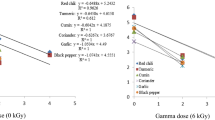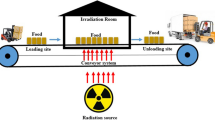Abstract
Several types of whole pulses (green lentils, red lentils, yellow lentils, chickpeas, green peas, cowpeas and yellow peas) and grams (black grams, red grams and white grams) have been investigated for the identification of radiation treatment using microgel electrophoresis of single cells (DNA comet assay). Pulses and grams were exposed to the radiation doses of 0.5, 1.0 and 5 kGy covering the legalized commercial dose range for protection from insect/pest infestations. All irradiated samples showed comet like stretching of fragmented DNA toward anode, which is expected for irradiated samples. Unirradiated samples showed many intact cells/nuclei in form of round stains or with short faint tails, which is typical for unirradiated food samples. The study shows that DNA comet assay can be used as a rapid, inexpensive and highly effective screening test for the detection of radiation treatment of foods, like pulses and grams.

Similar content being viewed by others
References
Anon (1991) Insect disinfestations of food and agricultural products by irradiation, IAEA, Vienna, pp. 1–174.
Anon (1999) Food and environmental protection newsletter, 2(2) IAEA, Vienna, p. 13
Cerda H, Delincée H, Haine H, Rupp H (1997) The DNA “Comet Assay” as a rapid screening technique to control irradiated food. Mutat Res 375:167–181
Delincée H (1996) Introduction to DNA methods for identification of irradiated foods. In: McMurray CH, Stewart EM, Gray R, Pearce J (eds) Detection methods for irradiated foods—current status. Royal Society of Chemistry, Cambridge, pp 345–348
Delincée H (1998) Detection of food treated with ionizing radiation. J Trends Food Sci Technol 9:73–82
Delincée H, Khan AA, Cerda H (2003) Some limitations of detection of irradiated seeds using the DNA Comet Assay. J Eur Food Res Technol 216:343–346
Diehl JF (1995) Safety of irradiated food, 2nd edn. Marcel Dekkar, New York
Haine H, Jones L (1996) Microgel electrophoresis of DNA to detect irradiation treatment of seeds. J Food Sci Technol Today 10(3):173–175
ICGFI (1994) Guidelines for the authorization of food irradiation generally or by classes of food. ICGFI Document No. 15, ICGFI, Joint FAO/IAEA Division. IAEA, Vienna
Khan HM, Delincée H (1998) Detection of irradiation treatment of foods using DNA ‘Comet Assay’. Radiat Phys Chem 52:141–144
Khan AA, Delincée H (1999) DNA ‘Comet Assay’ for detection of irradiated food: 5 . Deutsche Tagung Lebensmittelbestrahlung. In: Ehlermann DAE (ed) Bericht der Budesforschungsanstalt für Ernährung, BFE-99-01, Karlsruhe, p 316.
Khan AA, Khan HM (2008) DNA-Comet Assay-A simple screening technique for identification of some irradiated foods. J Radioanal Nucl Chem 275:337–342
Khan AA, Khan HM, Delincée H (2002a) Identification of irradiated spices using the novel technique of DNA Comet Assay. J Food Sci 67:493–496
Khan AA, Khan HM, Delincée H (2002b) Detection of radiation treatment of beans using DNA Comet Assay. Radiat Phys Chem 63:407–410
Khan AA, Khan HM, Delincée H (2003) DNA Comet Assay—a validity assessment for the identification of radiation treatment of meats and seafood. J Eur Food Res Technol 216:88–92
Khan AA, Khan HM, Delincée H (2005) DNA Comet Assay—a rapid screening method for detection of irradiated cereals and tree nuts. J Food Control 16:141–146
Loaharanu P, Thomas P (eds) (2001) Irradiation for food safety and quality. Technomic Publishing Co., Lancaster
McKelvey-Martin VJ, Green MHL, Schmezer P, Pool-Zobel BL, De Meo MP, Collins A (1993) The single cell gel electrophoresis assay (comet assay). A European Review. Mutat Res 288:47–63
McLaughlin WL, Chen YD, Soares CG, Miller A, Van Dyke G, Lewis DF (1991) Sensitometry of the response of a new radiochromic film dosimeter to Gamma radiation and electron beams. J Nucl Instrum Meth A 302:165–176
Molins RA (ed) (2001) Food irradiation: Principles and applications. Wiley, New York
Rojas E, Lopez MC, Valverde M (1999) Review: single cell gel electrophoresis assay: methodology and applications. J Chromatogr B 722:225–254
Verma AK, Banerjee R (2010) Dietary fibre as functional ingredient in meat products: a novel approach for healthy living—a review. J Food Sci Technol 47:247–257
WHO (1999) High-dose irradiation: Wholesomeness of food irradiated with doses above 10 kGy. Report of a joint FAO/IAEA/WHO study group. Geneva: WHO. Tech Rep Ser 890:1–197
Yadav BS, Sharma A, Yadav RB (2010) Resistant starch content of conventionally boiled and pressure-cooked cereals, legumes and tubers. J Food Sci Technol 47:84–88
Acknowledgments
We are thankful to Federal Research Centre for Nutrition, Karlsruhe, Germany for use of research facilities and Dr. Henry Delincée for useful discussions. The authors are also grateful to the Ministry of Science and Technology, Islamabad for Ph. D. fellowship to AAK, including a research stay at Germany, and to Humboldt Foundation for A. von Humboldt fellowship to HMK.
Author information
Authors and Affiliations
Corresponding author
Rights and permissions
About this article
Cite this article
Khan, H.M., Khan, A.A. & Khan, S. Application of DNA comet assay for detection of radiation treatment of grams and pulses. J Food Sci Technol 48, 718–723 (2011). https://doi.org/10.1007/s13197-010-0169-z
Revised:
Accepted:
Published:
Issue Date:
DOI: https://doi.org/10.1007/s13197-010-0169-z




